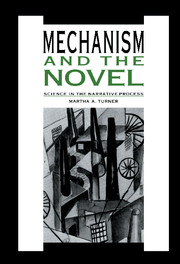Book contents
- Frontmatter
- Contents
- Acknowledgments
- 1 Introduction
- 2 The concept of mechanism
- 3 The Aristotelian logic of settlement in Austen's Pride and Prejudice
- 4 Scott's The Bride of Lammermoor: empiricism, mechanism, imagination
- 5 Cosmology and chaos in Dickens's Bleak House
- 6 Scientific humanism and the Comic Spirit: from The Ordeal of Richard Feverel to The Egoist
- 7 Old mindsets and new world-music in Conrad's The Secret Agent
- 8 Women in Love: beyond fulfillment
- 9 The mechanistic legacy: Lessing's Canopus in Argos: Archives
- Notes
- Bibliography
- Index
9 - The mechanistic legacy: Lessing's Canopus in Argos: Archives
Published online by Cambridge University Press: 19 January 2010
- Frontmatter
- Contents
- Acknowledgments
- 1 Introduction
- 2 The concept of mechanism
- 3 The Aristotelian logic of settlement in Austen's Pride and Prejudice
- 4 Scott's The Bride of Lammermoor: empiricism, mechanism, imagination
- 5 Cosmology and chaos in Dickens's Bleak House
- 6 Scientific humanism and the Comic Spirit: from The Ordeal of Richard Feverel to The Egoist
- 7 Old mindsets and new world-music in Conrad's The Secret Agent
- 8 Women in Love: beyond fulfillment
- 9 The mechanistic legacy: Lessing's Canopus in Argos: Archives
- Notes
- Bibliography
- Index
Summary
Mechanistic science is concerned above all with order. Despite changing conceptions of the domain and scope of scientific investigation, one constant for scientists throughout the nineteenth century and into the twentieth was their common ambition to articulate the laws (preferably expressed as mathematical equations) behind various material phenomena. A corollary assumption – perhaps the most distinctively nineteenth-century contribution to the mechanistic tradition – is the belief that all phenomena possess such regularities. The “matter, motion, and laws” approach which allowed Newton to explain the movements of celestial bodies led nineteenth-century scientists to insights about atomic structure, energy transference, and speciation, among other things; it continues to produce spectacular results today (in microchip technology, for instance) even though current views on the structure of matter and the nature of force diverge considerably from those held in Newton's day. In a 1980 lecture on the future of physics, Stephen Hawking proclaimed: “We already know the physical laws that govern everything we experience in everyday life.” Implicit in Hawking's confident assertion is a cognitive ploy central to the mechanistic tradition: the gesture of looking beneath or beyond sensory experience for patterns to organize these experiences. This generalizing or reductionist element in modern science has long been singled out for criticism. Alfred North Whitehead called it the “Fallacy of Misplaced Concreteness,” a tendency to confuse scientific abstractions with reality as it is seen and felt.
- Type
- Chapter
- Information
- Mechanism and the NovelScience in the Narrative Process, pp. 153 - 170Publisher: Cambridge University PressPrint publication year: 1993



